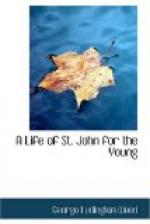This cloud overshadowed the disciples. As its light gleamed upon them, they were filled with reverential fear. They were ready to do the heavenly visitors immediate and humble service. But the mission of the two was ended. Their last words of comfort to Jesus had been spoken. If they could be detained, it must be done quickly. So, awed and confused by the strange vision, yet longing for its continuance, the disciples, Peter being the spokesman, proposed to make booths for their Master and His two heavenly visitors. But the two had gone, and the crown of glory that had enveloped them spread to the disciples, filling them with yet increasing awe. The silence that had followed Peter’s call was broken. “There came a voice out of the cloud, This is My Beloved Son; hear ye Him.” Startled by such a response, “they fell on their face and were sore afraid.” They did not dare to look about them. The Cloud of Glory lifted. How long they lay prostrate and trembling, we do not know. At last a hand gently touched them. It was the hand of Jesus. His voice bid them, “Arise, and be not afraid. And when they had lifted up their eyes they saw no man, save Jesus only.”
[Illustration: THE TRANSFIGURATION Old Engraving Page 106]
The Transfiguration was over. Its grand purpose was accomplished. Master and disciples were prepared for the labors and trials to which they must return. The night ended. As the morning sun glistened on the peaks of Hermon, while darkness yet overspread the plain below, Jesus descended with the three, to the nine awaiting their return.
“And as they were coming down from the mountain, He charged them that they should tell no man what things they had seen, save when the Son of Man should have risen again from the dead. And they kept the saying, questioning among themselves what the raising again from the dead should mean.”
Peter’s and John’s memories of that vision of their Lord were ever distinct and precious. When it was no longer a secret, Peter wrote in ecstasy of the hour in which they “were eyewitnesses of His majesty, ... when they were with Him in the holy mount.”
Let us notice the record by John. In the beginning of his gospel he says “The Word was made flesh and dwelt amongst us.” By this he means that the Son of God became a man, and lived among men who witnessed His life. But of all the events of that life which John had seen, there was a special one in his mind, which not all men had witnessed. So he adds, “We beheld His glory.” This probably refers to the Transfiguration and the Shechinah, which he and Peter and James had seen. And then he thinks of how much greater Jesus was than John the Baptist, “a man sent from God,” “to bear witness of” Him. He thinks also of the great Lawgiver of whom he says, “the Law was given through Moses; grace and truth came by Jesus Christ.”
We imagine that ever after the Transfiguration, John thought of Moses and the Shechinah together. Had he with his companions been permitted to build three tabernacles or booths, “one for Moses,” what delightful visits John would have made him there, like that one which he had made in the abode of Jesus on the banks of the Jordan.




